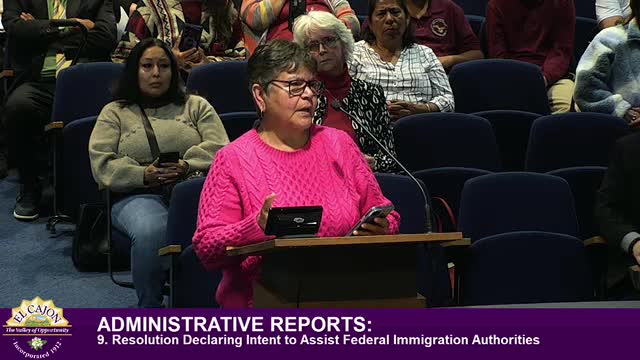El Cajon residents demand inclusivity as council considers controversial police resolution
January 14, 2025 | El Cajon, San Diego County, California
This article was created by AI summarizing key points discussed. AI makes mistakes, so for full details and context, please refer to the video of the full meeting. Please report any errors so we can fix them. Report an error »

The City of El Cajon held a council meeting on January 14, 2025, addressing several community concerns, particularly regarding a proposed resolution that has sparked significant debate among residents.
The meeting began with public comments, where community members expressed their views on the resolution, which some believe could marginalize certain groups within the community. One speaker raised concerns about the potential impact on both documented and undocumented families, arguing that the resolution might discourage individuals from reporting crimes or engaging with law enforcement. The speaker emphasized the importance of adhering to existing laws, specifically referencing SB 54, which they believe should guide police enforcement practices.
Another resident, Dr. Sergio Conti, highlighted the linguistic diversity within El Cajon, noting that nearly 30% of the population speaks Spanish. He urged the council to consider providing translation services during meetings to ensure all community members can fully participate and understand the discussions. Dr. Conti also shared personal insights about the contributions of the Hispanic community to the local economy, particularly in agriculture, and called for recognition of their hard work and integration into the community.
The council members listened to the public comments but maintained a strict three-minute limit for each speaker, which led to some frustration among attendees who felt their concerns were not fully addressed.
As the meeting progressed, the council continued to deliberate on the resolution, weighing the implications of its passage on community relations and public safety. The discussions underscored the ongoing challenges faced by local government in balancing law enforcement duties with the needs and concerns of a diverse population.
In conclusion, the meeting highlighted significant community concerns regarding inclusivity and representation in local governance. The council is expected to further evaluate the resolution and its potential effects on the community before making a final decision. Future meetings may provide additional opportunities for public input and discussion on these critical issues.
The meeting began with public comments, where community members expressed their views on the resolution, which some believe could marginalize certain groups within the community. One speaker raised concerns about the potential impact on both documented and undocumented families, arguing that the resolution might discourage individuals from reporting crimes or engaging with law enforcement. The speaker emphasized the importance of adhering to existing laws, specifically referencing SB 54, which they believe should guide police enforcement practices.
Another resident, Dr. Sergio Conti, highlighted the linguistic diversity within El Cajon, noting that nearly 30% of the population speaks Spanish. He urged the council to consider providing translation services during meetings to ensure all community members can fully participate and understand the discussions. Dr. Conti also shared personal insights about the contributions of the Hispanic community to the local economy, particularly in agriculture, and called for recognition of their hard work and integration into the community.
The council members listened to the public comments but maintained a strict three-minute limit for each speaker, which led to some frustration among attendees who felt their concerns were not fully addressed.
As the meeting progressed, the council continued to deliberate on the resolution, weighing the implications of its passage on community relations and public safety. The discussions underscored the ongoing challenges faced by local government in balancing law enforcement duties with the needs and concerns of a diverse population.
In conclusion, the meeting highlighted significant community concerns regarding inclusivity and representation in local governance. The council is expected to further evaluate the resolution and its potential effects on the community before making a final decision. Future meetings may provide additional opportunities for public input and discussion on these critical issues.
View full meeting
This article is based on a recent meeting—watch the full video and explore the complete transcript for deeper insights into the discussion.
View full meeting
